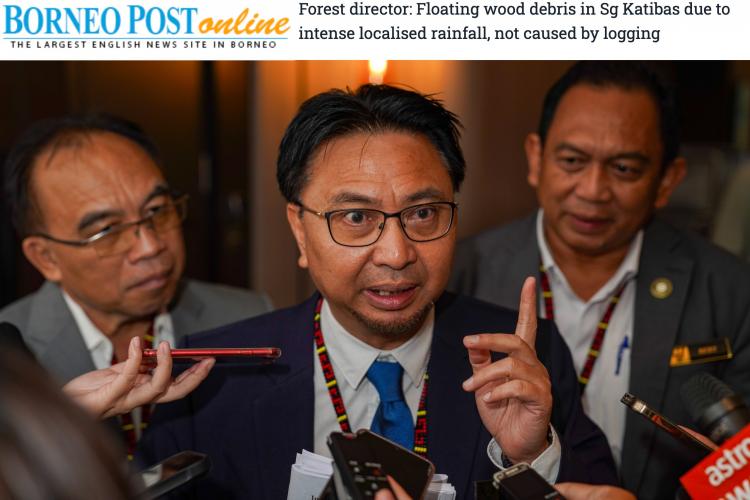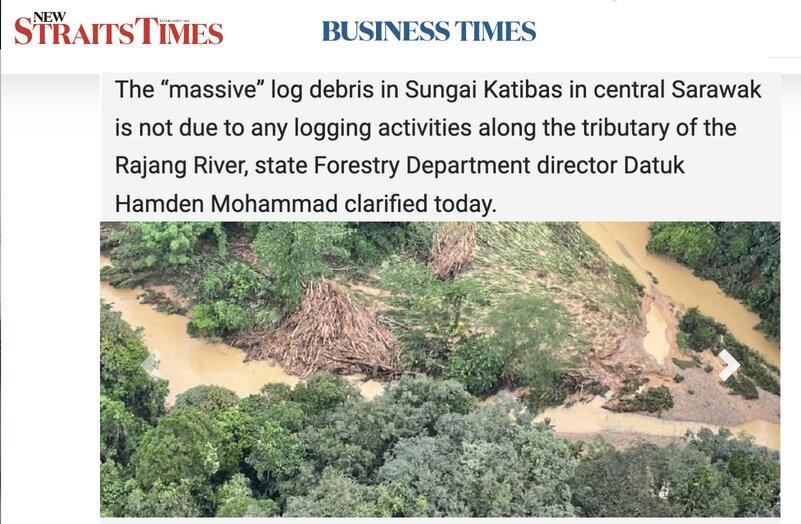On Wednesday, as people in the Kapit area became aware of a massive log jam surging down Sungai Katibas river from the supposedly protected area of the Lajak Entimau wildlife sanctuary, the director of the Sarawak Forestry Department issued an emphatic statement.
The mass of floating logs had nothing to do with any logging activities along the tributary of the Rajang River said Hamden Mohammad, as reported in several newspapers.
The reason he knew the “debris of deadwood and uprooted trees” washed down from the wildlife sanctuary could not be from logging, said Hamden, was because the activity is banned in the “totally protected area”.
Instead, the top state forestry man put the whole thing down to landslides. According to the New Straits Times:
Hamden said from satellite photos taken last Sunday, there were at least 10 landslides spotted in the sanctuary which is within the Ulu Katibas water catchment area.
“Based on meteorological and hydrological data, the high intensity of rain that had occurred within the catchment could have caused the landslides along Sungai Nyawai, Takai and Kalimau Besar (tributaries of Sungai Katibas).” [NST]
He went on to say his officers were still conducting an aerial reconnaissance to determine the extent of the “natural occurrence“.
Roots & Branches?
Except, as people on the spot were pointing out and anyone can see from photos, there was no sign of uprooted trees, simply sawn off trunks without roots or branches let alone leaves. What’s more this was visibly not fresh foliage, it was dried out dead wood.
Within hours, the local YB, Lidam Assan, was calling foul and demanding answers. ”
“I have called on the authorities to check the source of these logs and wood waste. There could be indiscriminate felling of trees along the rivers, causing these big amounts of logs and wood waste to be washed into the rivers by the flash floods,” he told reporters.
But no: in a further statement reported later that day by the Borneo Post, Hamden Mohamed rebutted the charge by explaining that while it turns out there are logging permits operating up river of the disaster zone after all, these could not have the the source of all the logs.
Why? because the State Forests Department has imposed a buffer zone for the area (to protect the river banks).
“Logging activities are there also but they have a systematic way to do it and there’s also the buffer zone that we imposed so this incident is not much on the logging activities but more of a nature disaster,” he said.

The director in the process appeared to contradict his earlier explanation that the trees had come from landslides which “uprooted” trees within the protected wildlife park, by claiming the park was in fact too far away to be the source of the bombardment.
The mystery deepened and by all reports the local YB protested louder.
Bingo! By Thursday there was a change of tune with some news outlets even updating their earlier reports to accommodate a new line from the forestry department.
The Vibes, for example, altered its previous reporting of Hamden Mohammed’s claims about landslides to cover a revised acknowledgement that logging is after all to blame.
However, not illegal logging:
“We have identified the source of these timber debris to be from timber concession sites that were hit by flash floods.
These logs and debris are not due to illegal logging” claims Hamden.
If so, how could legal logging operations, abiding by all the rules and the buffer zone requirements, have caused this deluge?
Since the cause of the log jam is now identified as legal logging, the forestry chief should name those operators responsible and explain how properly licensed and regulated timber practices could have possibly have resulted in such a dangerous accumulation of vast quantities of debris that could be so destructively washed away in heavy rains to damage the river, kill vast quantities of natural wildlife and threaten the safety of local people?
The top forestry officer apparently had time to survey the area and identify ten landslides but not to realise that legal logging, supposedly buffered, was also in the line of potential supply for debris in the river!
Such shifting stories undermine confidence. Why is there such a determination by this man in charge of safeguarding Sarawak’s forest base to rule out the obvious possibility (as stated by the local YB) that unauthorised logging or poor logging practices could be the problem?
How could well regulated logging produce this outcome?
All this from a forestry boss who seemingly can’t distinguish between fresh wood trees swept into the deluge through landslides and dried out sawn logs and debris.
Lidam Assan should get his full enquiry.
Topping the investigation should be why so many landslides took place in a supposedly intact and totally protected forest and how come a ‘buffer zone’ turned out to provide no buffer at all once the heavy rain fell?

